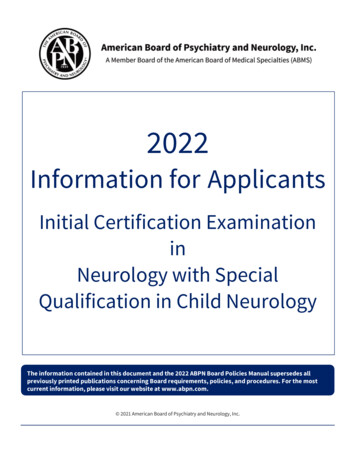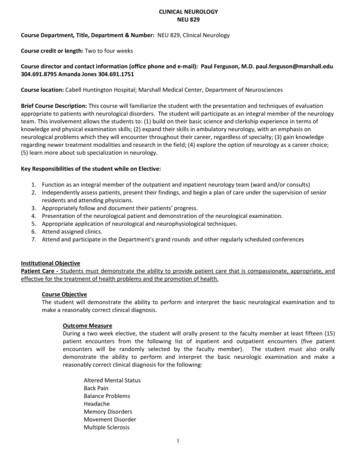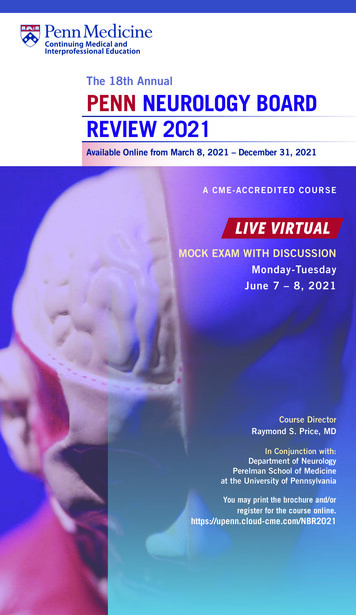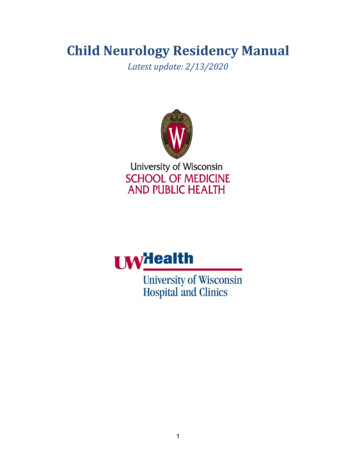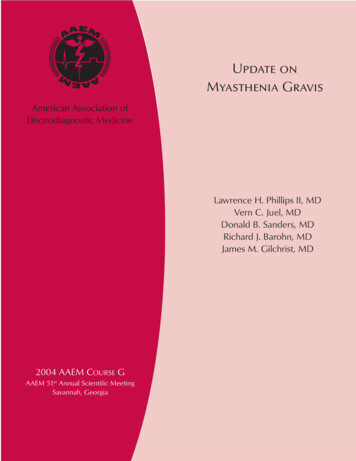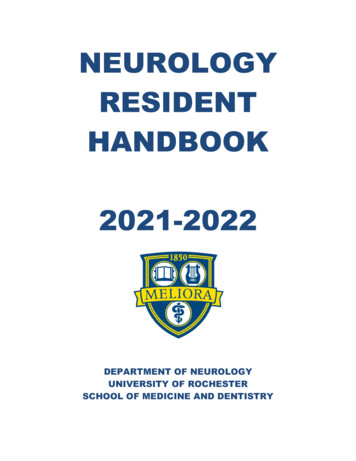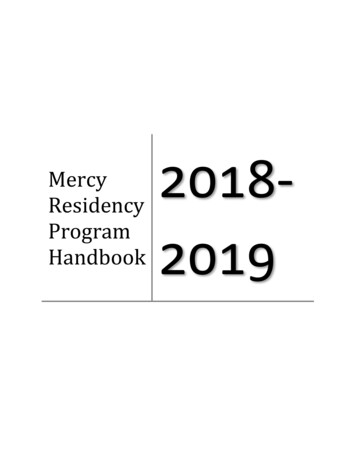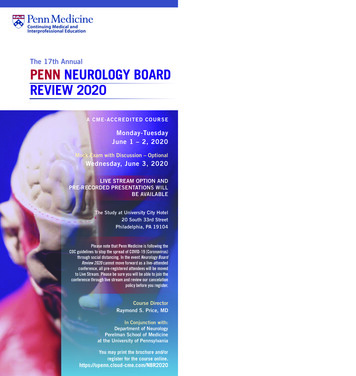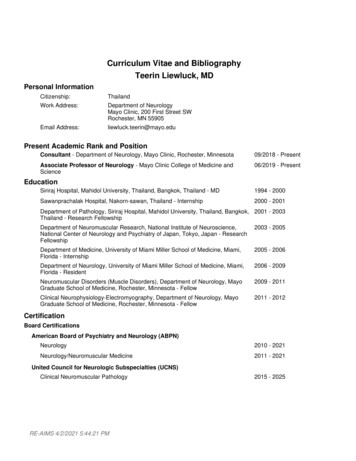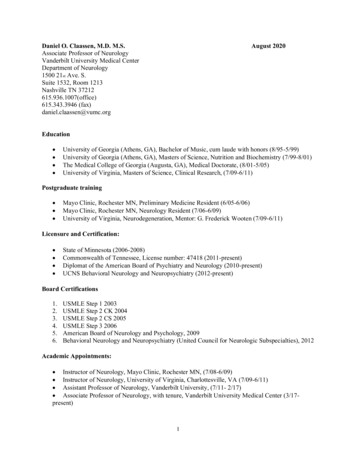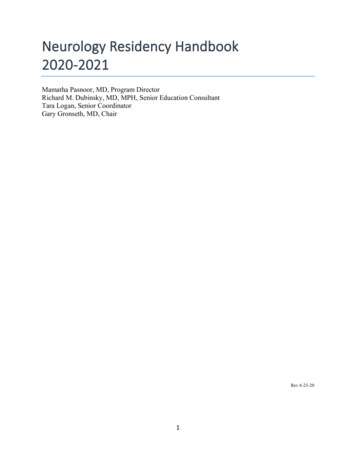
Transcription
Neurology Residency Handbook2020-2021Mamatha Pasnoor, MD, Program DirectorRichard M. Dubinsky, MD, MPH, Senior Education ConsultantTara Logan, Senior CoordinatorGary Gronseth, MD, ChairRev 6-23-201
Table of Contents:FOREWORD .5PART 1 POLICIES AND PROCEDURES AND WHAT IS EXPECTED OF LEARNERS .6MISSION STATEMENT, DEPARTMENT GOALS AND OBJECTIVES . 6GME Policy & Procedure Manual 7EXPECTATIONS OF LEARNERS . 8STRONGLY SUGGESTED TEXTBOOKS: . 11PART 2 ACGME MILESTONES AND NEUROLOGY CORE COMPETENCIES . 12PART 3 WORK ENVIRONMENT . 15PART 4 – DIDACTICS . 18NEUROLOGY CONFERENCE SCHEDULE . 18ARCHIVING OF DIDACTICS . 18CORE COMPETENCY LECTURES . 18NEUROLOGY CONFERENCES: . 18PART 5 TRAINING OVERVIEW . 21PGY 1 . 21PGY1 LEARNING OBJECTIVES . 21PGY 2 . 21PGY2 LEARNING OBJECTIVES: . 22DESCRIPTION PGY3: . 22PGY3 LEARNING OBJECTIVES: . 22DESCRIPTION PGY4: . 23PGY4 LEARNING OBJECTIVES: . 23PEDIATRIC NEUROLOGY FELLOW . 24SCOPE OF PRACTICE: . 24PART 6 HOW WE DO THINGS . 25CASE PRESENTATION . 25KUH INPATIENT ROTATIONS . 25KANSAS CITY VAMC CLINIC AND CONSULT SERVICES . 26NIGHT FLOAT / CLINIC ROTATION. 26LONGITUDINAL CLINICS. 26OTHER MANDATORY ROTATIONS . 26NEUROPATHOLOGY / NEURORADIOLOGY . 26NICU . 27PEDIATRIC NEUROLOGY . 27SUPERVISING RESIDENT KUH WARDS . 27PSYCHIATRY . 27ELECTIVE GUIDELINES . 27CLINICAL ELECTIVES: . 272
HAND-OFFS. 29NIGHT FLOAT AND HAND-OFFS . 30TRANSITIONS IN CARE . 30NOTES . 30WEEKEND ROUNDS AT KUH AND DIVISION OF WORK . 31INPATIENT WARDS SERVICE ON CONTINUITY CLINIC DAYS: . 31PART 8 – RESEARCH INITIATIVES . 38RESIDENT RESEARCH EXPERIENCE . 38RESIDENT AND FELLOW RESEARCH SYMPOSIUM . 39PART 9 – POLICIES . 39POLICY ON SELECTION OF RESIDENTS . 39LEVEL OF APPOINTMENT GUIDELINE . 40COMMUNICATION COMPETENCY REQUIREMENT . 40INTERNATIONAL MEDICAL GRADUATES . 40POLICY ON RESIDENT SUPERVISION. 40POLICY ON PROGRESSIVE RESPONSIBILITY FOR PATIENT MANAGEMENT . 43POLICY ON RESIDENT WORK HOURS . 43POLICY ON FATIGUE . 43VACATION POLICY. 43ACADEMIC LEAVE . 44FMLA . 44DISABILITY . 44POLICY ON EVALUATION AND PROMOTION OF RESIDENTS . 44POLICY ON EVALUATION OF FACULTY AND OF THE RESIDENCY PROGRAM . 44GME RESIDENT FUNDS . 45RESIDENT TRAVEL TO SCIENTIFIC MEETINGS . 45MOONLIGHTING POLICIES . 45COMPUTER SECURITY . 45SOCIAL MEDIA POLICY . 45OMBUDSMAN . 45DEPARTMENT OF NEUROLOGY CLINICAL FACULTY . 48IMPORTANT DATES FOR AY 2019-2020: . 50APPENDICES: . 51NEUROLOGY MILESTONES . 51NEX FORMS . 51CHART DOCUMENTATION . 51GOALS & OBJECTIVES:. 89ELEMENTS AND STYLE OF NOTES, CONSULTS, DISCHARGE SUMMARIES AND CORRESPONDENCE . 181ELEMENTS AND STYLE OF A GOOD HISTORY AND PHYSICAL . 182HOSPITAL PROGRESS NOTES:. 183ELEMENTS AND STYLE OF A GOOD DAILY PROGRESS NOTE . 184ELEMENTS AND STYLE OF A GOOD DISCHARGE SUMMARY . 185ELEMENTS AND STYLE OF A GOOD CLINIC NOTE. 1863
ELEMENTS AND STYLE OF GOOD CORRESPONDENCE . 188BILLING AND CLINICAL DOCUMENTATION . 188GMEC Resident Supervision Template 1894
ForewordThis handbook encompasses the basic information for our neurology residency programand is updated annually. The handbook is in three parts, the first is Policies, Procedures andWhat is Expected of Learners; the second section is the Goals & Objectives; and the third isrotation specific information and other items (How We Do Things).This handbook is in harmony with the GME Policy and Procedure s-and-procedures.html). Where there is adiscrepancy, this stricter policy takes precedence. For example, while moonlighting is possiblewithin certain GME imposed restrictions it is not allowed for neurology residents.The Neurology Residency Review Committee mandates that this is distributed annuallyto all clinical faculty and residents in our department. All should be familiar with the goals andobjectives, rotation guidelines and policies included in this handbook. A thorough understandingof these goals, guidelines and policies helps our residency program runs smoothly and meets itsmissions.Mamatha Pasnoor, MDProfessor and Program DirectorDepartment of Neurology5
Part 1 Policies and Procedures and What is Expected of LearnersMission Statement, Department Goals and ObjectivesDepartmental Mission StatementThe mission of the Department of Neurology is to provide the best possible clinical carefor patients and the best possible education for medical students, residents, and fellows whileengaged in world-class research in the neurosciences. These goals are accomplished through thehigh caliber faculty, house officers, and support staff employed by the department and with thesupport of The University of Kansas Health System (TUKHS), the Kansas City Veterans AffairsMedical Center, and Children’s Mercy Hospital.Departmental Goals To provide general and subspecialty neurology clinical services to patients from thegreater Kansas City metropolitan area and to the state of Kansas and surroundingareas.To provide the training so that our house officers excel in clinical care and inresearch.To provide instruction in the basic and clinical neurosciences to medical students,allied health students, and to house officers in other disciplines.To promote and support basic science and clinical research in the neurosciences.To achieve national recognition of our clinical and research endeavors.Educational Mission StatementThe educational mission of the Department of Neurology is to provide an optimaleducational environment to prepare the neurology resident for the independent practice ofclinical neurology. An experienced faculty with board certification by the American Board ofPsychiatry and Neurology, with subspecialty expertise in all major disciplines of neurology,assures, through close supervision, that neurology residents receive extensive exposure to thebasic neurosciences and clinical skills. The program director and neurology faculty ensure thatpatient care responsibilities are balanced with teaching to enhance the educational experience ofthe neurology resident. Our residents are trained to communicate effectively with their patientsand families in a caring and respectful manner. Residents are trained to apply knowledge ofstudy designs and statistical methods to the appraisal of clinical studies, assessing diagnostic andtherapeutic effectiveness. They learn how to practice cost-effective health care and allocateresources without compromising care quality.Educational GoalsThe educational goals of the Neurology residency program are to: Train clinicians for independent practice of Neurology, Provide the educational background for lifelong learning in Neurology, Encourage participation in clinical research during training, and throughout thecareers of our graduates, and Train our residents to provide compassionate care for their patients, and the familiesof their patients.6
Educational Objectives:The Neurology resident will: Through supervised clinical work, become proficient in the care of the neurologicalpatient Assume increasing responsibility for the evaluation and management of neurologypatients in the hospital and in the clinic Through lectures, and independent study, develop a foundation of knowledge in thebasic neurosciencesGraduate Medical Education Policy & Procedure Manual;The Neurology resident can access the policy and procedure manual for the Office of GraduateMedical Education (GME), here: s-andprocedures.htmlRev 4-28-20207
Expectations of LearnersThese are both the explicit and implicit (hidden curriculum) for Neurology residency. Thecompetencies for each expectation are in the parentheses:1. Show up on time. (Prof.)a. To not is unprofessional and expresses your disdain and disregard for others.This is for all lectures, conferences, team huddle and rounds.2. Be prepared (Patient Care, Prof.)a. Do the background readingb. See patients before rounds, pre-rounding electronically is not enough.c. Review patient charts before clinicd. Know what is going on by the morning Huddle3. Arrive ready and willing to learn (Medical Knowledge)a. Learning is an active processb. Your study time away from the hospital is when you learn the factsc. Rounds and lectures are places to learn concepts and how to put things togetherd. You are expected to spend at least one hour a day on your own on didactics.e. Minimum score on RITE is 40th percentile for rank.4. Be engaged (Prof.)a. Your activities are directed to the task at handb. Accessing information beyond the background reading, before a presentation oreven during is goodc. Using a digital device to do something else is notd. Make eye contact with the teacher, ask and answer questions, participate5. Don’t pretend to know what you don’t (Prof. Interpersonal Communication Skills)a. For factual data (e.g. a laboratory result) admit it if you don’t know the answer.i. Make sure you know the answer the next time, and every time after thatb. Guessing is encouraged, just be honest. If you don’t know the mechanism of adisease or a treatment, speculate. “Luck favors the prepared” Edna Mode (TheIncredibles 2004) “Fortune favors the prepared mind.” Louis Pasteur6. Completion of notes (Pt. Care, Prof, ICS, Systems Based Practice)a. Inpatient notes are to be completed by end of that business day.b. Clinic notes are completed within three days (TUKHS rule)c. Consult notes are started before the patient is seen by the attending physicianand completed by the end of the business day that the patients is seen by staff.d. ED consultations should be completed before you leave the ED. A brief notewithin 30 minutes of staffing the patient, a complete note within five hours.e. Notes from stroke activation calls are completed by the end of the activation.f. Do not copy and paste your notes or plagiarize the notes of others. You maycopy appropriate history forward. Any examination that you document must bethe examination that you did that day.7. Administrative tasks (Prof.)a. Duty hours are always up to date8
b. Evaluations are completed within two days of assignment.c. Vacation and elective requests are completed at least 60 days in advanced. Administrative tasks are completed promptlyi. Pages are answeredWhat is an honors level resident?1. All of the above plus:2. Be prepared (Patient Care, Med, Know., Prof.)a. Seeks out additional background reading. For example, in Journal club they readnot only the article, but seek out the background articles on the outcomeassessment tool (e.g. UPDRS)3. Proof of learning (Medical Knowledge)a. RITE score above 80th percentile for rank.4. Be engaged (Prof. ICS, SBP)a. Actively involved in participation in roundsb. Teaches other learners (residents and students) in an exemplary fashion.c. Knows when to be quiet to give someone else a chance.5. Notes (Pt. Care, Prof, ICS, Systems Based Practice)a. Notes are complete, are not only concise, are accurate and prepared ahead oftime,b. Notes contain concise, pertinent, differential diagnosis showing their thoughtprocesses and a discussion of therapeutic optionsc. Discharge summaries are concise and have clear instructions for what needs tobe done (test results, scheduled therapies, follow-up appointments)6. Administrative tasks (Prof.)a. Never needs reminders to perform administrative tasks.b. Keeps tracks of, and renews licenses, DEA permit, BLS and ACLS.Rev 6-24-20189
The Next Accreditation System (NAS) and GradesThe 29 milestones in Neurology are mapped onto the six competencies. The levels ofthe milestones are based on Dreyfus model of learning. (Dreyfus 1980) These stages areanalogous to Levels 1-5 in the milestones but are not equivalent to post graduate year (or level)of training (PGY). Each level requires mastery of the one below.A novice learner knows the rules, applies them without explicit responsibility and mustdo everything by rote. They require constant supervisionA proficient learner knows the rules, accepts limited responsibility yet needs closesupervision or oversight. They can filter out unnecessary elements in their presentations, butstill need to do most everything in their evaluationsA competent learner is able to filter out the unnecessary elements quickly in theirclinical encounters and presentations. They not only grasp the nuances of commonpresentations of common disease, but also the common presentation of uncommon disease.They prioritize their evaluation based on the likelihood of the disorders in their differential andre-evaluate frequentlyAn expert learner quickly grasps the nuances of the situation. They develop ahypothesis, test it on the fly with questions, examination and tests and constantly re-evaluateand adjust accordingly.A master learner likes surprises. They seek out the exceptions to the rules and thusexpand our overall knowledge of a subject. They challenge assumptions and in doing soadvance the field. They are actively engaged in research in their discipline.For example, if a resident can correctly identify a patient as having progressivesupranuclear palsy (level 3 or 4), yet state that deep brain stimulation is the preferredtreatment for a patient with the recent onset of Parkinson’s disease (failed level 3), they areperforming at level 2, as long as they can tell the difference between hyper and hypokineticdisorders (level 2).10
Strongly Suggested Textbooks:PGY2 Neuroanatomy Through Clinical Cases, 2nd Edition,2011 (Hal Blumenfeld) Adams and Victor's Principles of Neurology 10th Edition Hardcover – 2014 Allan Ropper,Martin Samuels, Joshua Klein Manter and Gatz's Essentials of Clinical Neuroanatomy and Neurophysiology, 10thEdition (Gilman and Newmann), 2002 Introduction to Neuropsychopharmacology. Iversen, Iverson Bloom and Roth, 2008PGY3 and PGY4 Escourolle & Poirier's Manual of Basic Neuropathology, 5th Edition, 2013 (FrancoiseGray, Charles Duyckaerts, and Umberto De Girolami editors) Principles of Neural Science, Eric Kandel, 5th Edition Osborn's Brain: Imaging, Pathology, and Anatomy, Anne Osborn, 2012Worth buying if you can find it: Core Text of Neuroanatomy, Malcom Carpenter, 1991Your annual book budget is adequate to purchase all of these in PGY211
Part 2 ACGME Milestones and Neurology Core CompetenciesOver 10 years ago the American Council on Graduate Medical Education (ACGME)announced the six core competencies as part of an overhaul of post-graduate training forresidents. In 2012 the next step, aptly termed the Next Accreditation System (NAS) went intoeffect for many disciplines. The competencies were the lofty goals to be achieved throughtraining; the NAS incorporates milestones that must be achieved during the residency program.The milestones, while specialty specific are based on the Dreyfus Model of Skill Acquisition(Dreyfus SA, Dreyfus HI. A Five Stage Model of the Mental Activities involved in Direct SkillAcquisition. UC, Berkeley).The Novice is taught a set of rules before they acquire experience. This is the medicalstudent and intern. Competent: the learner applies the rules to the situation. This is the beginningneurology resident. Proficient: this learner can handle more than one situation at a time, and isable to appropriately and independently exclude irrelevant details. This is the advanced resident.Expert: learner is able to intuitively grasp the situation and to do the appropriate steps or actions.This is the resident who is about to complete their training. Master: in this stage the performer(or physician, or athlete ) no longer has to self-monitor their activities and they can transcendtheir performance at the expert level by using freed resources from self-monitoring into the taskat hand. The master seeks out unusual and difficult situations and welcomes surprises. This is theexperienced clinician who has developed style. The labels have been changed over time and inthe current ACGME learner model, master is level four and expert is level five. The take homemessages are that the levels are not equivalent to PGY and that a learner can perform at differentlevels for different milestones in their training. The first proposed milestone is:History– Patient CareLevel 1Level 2Obtains aneurological historyObtains a completeand relevantneurological historyLevel 3Level 4Level 5Obtains a complete,relevant andorganizedneurological historyEfficiently obtains acomplete, relevant.,and organizedneurological historyEfficiently obtains acomplete, relevant,and organizedneurological historyincorporating verbaland non-verbal cluesAs of July 1, 2014, the milestones are used as the basis for evaluations. When you reviewthe milestones, you will note that they are divided into the six competencies.ACGME Core Competencies:Patient Care: Residents must be able to provide patient care that is both appropriate andcompassionate and that is effective for the promotion of health and the treatment of healthproblems and disease. Residents must: Use all sources to gather essential and accurate information about their patients,including medical interviews, medical examinations, and medical records. Make informed recommendations to patients and their families regarding treatmentplans and recommended diagnostic and therapeutic interventions that are based uponpatient preference, scientific evidence, and clinical judgment. Develop and carry out patient management plans, counsel and educate patients andtheir families, and collaborate with other health care professionals (including those fromdifferent disciplines) to provide patient-focused care. Competently perform all essential medical and invasive procedures.12
Medical Knowledge: Residents must demonstrate knowledge about current and establishedclinical, biomedical, epidemiological, and social-behavioral sciences and will apply thisknowledge to patient care. Residents must: Learn the clinical aspects of adult and pediatric neurological disorders and the basisfor working up these conditions. Utilize readings to learn the causes of neurological conditions and apply thisknowledge in a clinical setting. Learn the appropriate use of diagnostic procedures used to detect common anduncommon neurological disorders.Practice-Based Learning and Improvement: Residents must be able to use informationtechnology, scientific methods, and scientific evidence to evaluate, investigate, and improvepatient care. Residents must: Use information technology, scientific methods, and scientific evidence to evaluate,investigate, and improve patient care. Identify areas for self-improvement and facilitate learning among students and otherhealth care professionals. Implement strategies to enhance patient care. Analyze practice experience and perform practice-based improvement activities usinga systematic methodology. Find and evaluate evidence from scientific studies related to patient health problemsand incorporate findings into patient care. Obtain and utilize information about their population of patients as well as the largerpopulation from which their patients are drawn.Interpersonal and Communication Skills: Residents must demonstrate interpersonal andcommunication skills resulting in effective communication with patients, families and othermedical professionals. Residents must: Create and sustain a therapeutic and ethically sound relationship with patients Use listening, nonverbal, explanatory, questioning and writing skills to effectivelyprovide information to and elicit information from patients, families and other medicalprofessionals. Work effectively with health care teams and other colleagues as a member or as aleader.Professionalism: Residents have an obligation to professionalism and sensitivity and mustadhere to ethical principles within a diverse patient population. Residents must: Demonstrate accountability, respect, integrity, and empathy toward patients and theirfamilies and to society. Demonstrate openness and sensitivity to the culture, age, gender, disabilities,socioeconomic status, beliefs and behaviors of patients, patients’ families, andprofessional colleagues. Adhere to ethical principles concerning the withholding of clinical care,confidentiality of patient information, informed consent, and business practices13
Be able to communicate with patients, families, members of the health care team, andcolleagues in clear, English, using and understanding North American and Midwesternidiomatic English. At all times residents must interact with patients, their families, and the staff with apleasant demeano
This handbook encompasses the basic information for our neurology residency program and is updated annually. The handbook is in three parts, the first is Policies, Procedures and What is Expected of Learners; the second section is the Goals & Objectives; and the third is rotation specific information and other items (How We Do Things).
